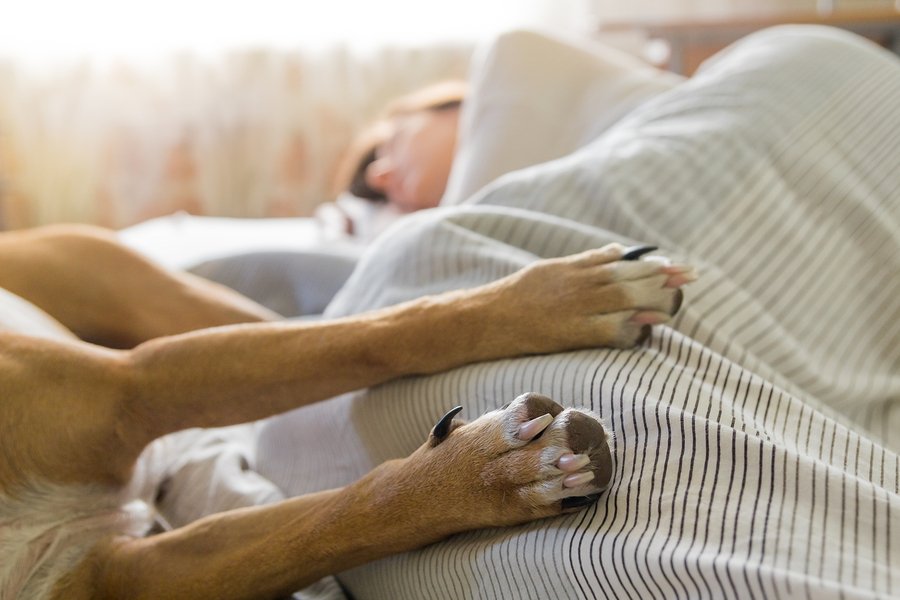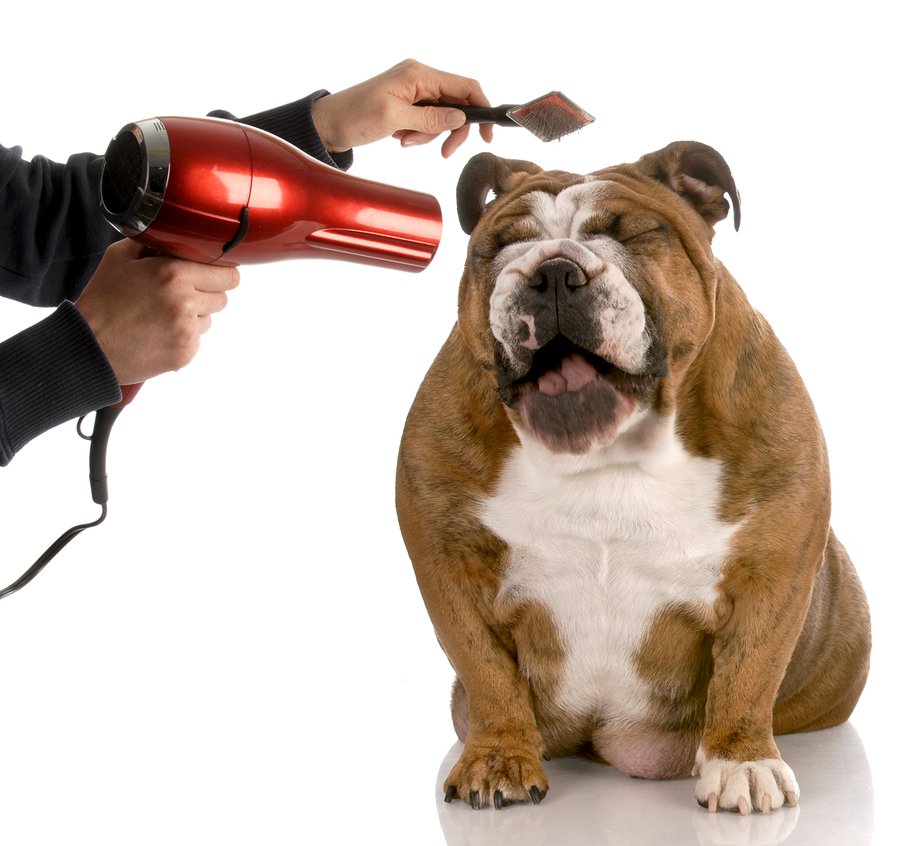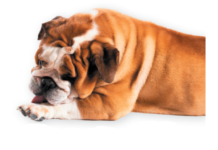Your dog doesn’t seem right, and you want to take her temperature to make sure she’s okay. But what should her temperature be? Is 98.6 degrees in the right range, as it is for us?
What about when it comes to drying her with a hair dryer after a bath? What’s a safe setting? What could burn her? And which brand of harness is the safest to keep her secured in the event of a collision? You might be surprised at the answers to these and other questions. See how well you do on our canine safety test. Note: Some questions have more than one right answer.
© Tropical Studio | Bigstock

1 True or false? Not all dogs love the water, but all dogs are natural swimmers so you don’t have to worry about them should they end up in a pool or lake.
False. Some dogs will never learn to swim because they’re simply not built for it. Basset hounds, dachshunds, and bulldogs have such short legs that many simply can’t paddle fast enough to keep their bodies afloat. Bulldogs in general are poor swimmers, like all brachycephalic breeds. And some dogs are simply too old or frail to make competent swimmers, while others are afraid of the water and want no part of it. For all these reasons, you should never leave a dog unattended when she’s in water over her head. If you do adjust her to a pool, show her where the shallow end is and how to exit safely. Some dogs panic in the deep end and, in their agitated state, keep swimming around in circles trying to find a way out rather than knowing to make their way for the pool stairs.
2 True or false? A lot of dogs eat super-fast, but it’s nothing to worry about. It’s just in their nature.
False. It’s true that it’s in a lot of dogs’ natures to eat fast. They have less than a quarter of the taste buds that we do, so they may feel it’s not worth savoring their food if the flavor is not going to be very intense. In addition, some dogs may eat fast as a remnant left over from their days as puppies, when they had to share meals with littermates and needed to make sure they got enough for themselves. (Have you noticed that some dogs pick up the pace of their eating if someone walks near their bowl during mealtime?) But it’s not true that super-fast eating is nothing to be concerned about.
Deep-chested, large-breed dogs who gulp down their food can be at risk of bloat, studies have shown. The quicker they eat, the more air they swallow, and it’s excess air that causes the bloating. We’re not just talking here about burping, stomach distention, and passing gas. A dog who eats too fast over a long period of time can end up with life-threatening gastric dilatation volvulus (GDV) — over-stretching and twisting that can cut off blood flow to a portion of the stomach.
If your dog is a gulper, you can slow his eating by trying any of the following: divide his food into more than two meals a day; split up each meal into several bowls around the house to enforce a breather after every few bites; turn his metal food bowl upside down and put the kibble along the ring surrounding the raised circle in the middle (assuming the underside of the bowl is indeed shaped something like a bundt pan, which many metal bowls are); buy a bowl that has plastic “fingers” in the center that your dog will have to eat around. Some of them, like the Brake-Fast Bowl, have slides that make a dog chase his food to a certain extent. Finally, you can use food toys like Kongs or food puzzles, which require work and time on the dog’s part to get to the good stuff.
3 True or false? Brushing your dog’s hair will make her look good, but it’s not necessary for her health.
False. Unless you have a curly-haired dog like a poodle or Portuguese water dog whose hair separates naturally and therefore doesn’t tangle, brushing is not just about vanity but also well-being. Even on short-haired dogs like beagles and Chihuahuas, without regular, weekly brushing (more often for long-haired dogs), mats and tangles can form that will prove uncomfortable and make it easier for infections to take hold. And once they do, they can be difficult to treat without shaving the affected spot, costing time and money in vet visits that will be necessary to chart progress. Hair that’s regularly brushed, by contrast, provides a good barrier against harmful bacteria and other pathogens. Brushing distributes oils from the dog’s skin throughout her coat and removes dirt, and that keeps her skin clean and free of irritants. It also keeps you feeling your dog’s skin more often, making you more apt to pick up things that shouldn’t be there — a tick, a lump, or a hot spot that needs medical attention.
Brushing doesn’t just strengthen the skin, by the way. It fortifies the psyche. For many dogs, brushing feels good and increases an owner’s bond with his pet. Any time you spend engaged in an activity with your dog (even if it’s while you’re watching television) is time she isn’t spending on her own.
Note: Owners of curly-haired dogs are not off the hook. Their dogs have to go to the groomer every three or four months to have any mats that do form removed and also to have their hair trimmed. So do dogs with straight hair that grows very long (think Lhasa Apsos and Shih Tzus.) They’ve got to be able to see and move around freely, after all.
4 You have found out your dog has high cholesterol. You
A. Immediately put him a low-fat diet because you don’t want him to get heart disease.
B. Suspect the dog may have a thyroid problem.
C. Worry because high cholesterol in dogs can sometimes cause seizures.
D. Don’t do anything because usually high cholesterol in a dog doesn’t signify anything medically.
B and C.High cholesterol in dogs very rarely has anything to do with a fatty diet that “clogs” the arteries and thereby blocks blood flow, leading to a heart attack. Indeed, dogs naturally have very little “bad” cholesterol in their blood and almost all “good” cholesterol, which provides them an advantage on that score. For dogs, almost all heart disease is about faulty valves that control the flow of blood between the heart’s four chambers, and it comes about not because of what a dog is fed but because of genetic programming that causes a valve to deteriorate and allow blood to flow backward rather than forward, like it’s supposed to.
So just what does high blood cholesterol signify for a dog? Often, it’s a marker for a disease involving the body’s endocrine system, which controls hormones. One of those diseases is hypothyroidism — too little production of thyroid hormone. Another is diabetes. The hormone insulin dissolves fat; too little insulin, and fat levels rise in the bloodstream. Cushing’s disease, which results in too much of the hormone cortisol, can result in high blood cholesterol, too, as can certain types of kidney disease and a kind of liver disease known as nephrotic syndrome. In pretty much all of these cases, once you treat the disorder, the dog’s cholesterol levels will return to normal. Sometimes, treatment of the disease will not reduce a dog’s high blood cholesterol, and he will need to go on a reduced-fat diet in order to cut down on the risk of untoward effects like vomiting and diarrhea or even seizures. But such instances are rare. Usually getting the disease under control takes care of the problem.
By the way, while high cholesterol for a person is anything over 200 (milligrams per tenth of a liter of blood), for a dog it’s anything over 350, depending on the lab and the reference values it uses.
© photoboyko| Bigstock

5 You should
A. Not allow your dog to sleep in the same bed as you because harmful bacteria can make their way from your pet’s coat onto you and make you sick.
B. Allow your dog to sleep on the bed with you even if you don’t want to share the mattress because 15,000 years of being domesticated to be right next to us makes it too difficult for them emotionally to be separated all night and leads to issues with anxiety.
C. Allow your dog to sleep on the bed with you sometimes but not all the time in order to reduce the risk of diseases being transferred from your pet to you but also allow for that physical closeness dogs need.
D. Just make a decision and stick with it.
D. There is no wrong answer (except C). Many people enjoy the nighttime company of their dogs and also want them to have that closeness, so into the bed they come. As long as they regularly give their pet the proper flea and tick medication, they’re not going to get sick from the close proximity. Others do not like sharing the mattress with their canine loved ones, and that’s okay, too. Maybe the dog snores or has a problem with conflict aggression and needs to be kept off high places, or perhaps the owner is allergic and gets too sick if the dog stays in the bed all night. Or maybe the owner simply wants more room for themselves.
The only thing you want to avoid is letting the dog sleep on the bed with you sometimes. Dogs don’t get “sometimes.” That’s why you can’t feed your dog from the table sometimes and get annoyed at others when he comes scrounging for scraps from your meal. If a dog likes something — sharing the bed, eating table scraps — he will get trained very, very quickly, and not so easily untrained. That’s why you can do “in the bed” or “out of the bed,” but not both.
6 True or false? Dogs should be kept from eating feces not only because it’s disgusting but also because they run the risk of ingesting harmful bacteria in the waste.
False. Disgusting, absolutely. We’re right there with you. But not harmful. Dogs may learn the habit from their mothers, who keep the whelping (birthing) area clean after they deliver a litter by eating their young’s feces. Some dogs go a step further than eating it and also roll around in it. Keep in mind that dogs “see” and “share” their world largely through their sense of smell, so when they roll around in something you find objectionable, they’re not trying to be gross. They’re saying, “Wow, this is so interesting. Look what I found! How neat it is that horses have trotted over this spot.”
Covering himself with the odor of excrement might also be a leftover from ancient times, when dogs ran wild and had to protect themselves. That is, rolling in the scent of another animal might have masked his own odor and thereby kept him “hidden” from predators trying to sniff him out — or from prey who would run away if they knew he was coming to get them.
Fortunately (for us), most dogs grow out of the habit when they reach the age of one or so — the end of puppyhood.
7 Your dog doesn’t seem right and you want to take her temperature to see if perhaps she has a fever. A normal reading for a dog is
A. 98.6
B. 97.8
C. 100
D. 101
E. 102
C, D, or E. A normal reading for a dog (taken with a rectal thermometer that you do not use on human family members) is not a single number, but a range: anywhere from 100 to 102.5 degrees Fahrenheit. By the way, forget feeling your dog’s nose to see if it’s cold and wet. That signifies nothing. A warm, dry nose could be consistent with perfect health, too.
© Willie Cole | Bigstock

8 True or false, if you’re going to dry your dog with a hair dryer after a bath, it should only be a dryer designed with dogs in mind as their thin skin can burn from a hair dryer meant for people.
False. It’s okay to use your own blow dryer, as long as you keep the heat at a low setting so it doesn’t burn your dog’s sensitive skin. If your dryer has ion technology that actually breaks down water molecules without relying on heat, so much the better.
That said, if you can spring for a dryer designed specifically for dogs, your pet will benefit even more. Dog dryers have motors working at such high speeds that the air shooting out of them literally blows the water off the hair as opposed to evaporating it with heat. Dog dryers also usually come with attachments that work for breeds of varying sizes, and they have insulation that keeps down the noise, which many dogs do not like. There are a number of good brands out there, including the ConairPro Dog Pet Dryer and the Air Force Quick Draw Dryer by Metro Vacuum.
9 The best way to keep your dog safe during car rides is to
A. Only drive her in an SUV and put up a gate between the back part, where she is, and the passenger seats. That way, if you have to stop short or have a collision, she will remain in a small area rather than flying around the vehicle like a projectile and potentially hurting herself — or you.
B. Restrain her in a seatbelt.
C. Restrain her in a crate made specially to be able to sustain the impact of a collision, and attach that crate to the back seat by hooking a seatbelt through it.
D. None of the above.
D. The state of affairs when it comes to dog safety in cars leaves plenty to be desired. First, there is no “best” way to protect your dog in your vehicle. Theoretically, a seatbelt designed for dogs, a crate attached to the back compartment of an SUV (not left loose behind a gate so that it can fly around and hurt the dog), or a carrier attached to the back seat of a sedan could all go a long way to increase safety for your pet. The problem is that very, very few devices pass muster in crash tests. Consider that in analyses conducted jointly by the Center for Pet Safety and Subaru of America, Inc., only a single pet harness proved truly protective during simulated crashes: the Sleepypod Clickit Utility.
When it came to crates meant to be kept secure in the back of an SUV, the top performer was the Gunner Kennel G1 Intermediate with 8-Foot Tie Down Straps. (That’s despite the fact that other brands had claims like “crash protection.”) The Gunner Kennel G1 retails for a not inconsiderable $500.
As far as carriers, only two did the job in crash tests: the Pet Ego Jet Set Forma Frame Carrier with ISOFIX-Latch Connection, and the Sleepypod Mobile Pet Bed with PPRS Handilock. Each of them fully held a dummy dog safely before, during and after a simulated crash, and their connections to the vehicle remained fully intact throughout.
Part of the reason for the dearth of reliable car safety devices for dogs is that there are no federal standards. The Consumer Product Safety Commission doesn’t classify pet products as consumer products, even though if a pet flies about during an accident, the human consumers can get hurt — or worse. The Center for Pet Safety is hoping to change that stance.





